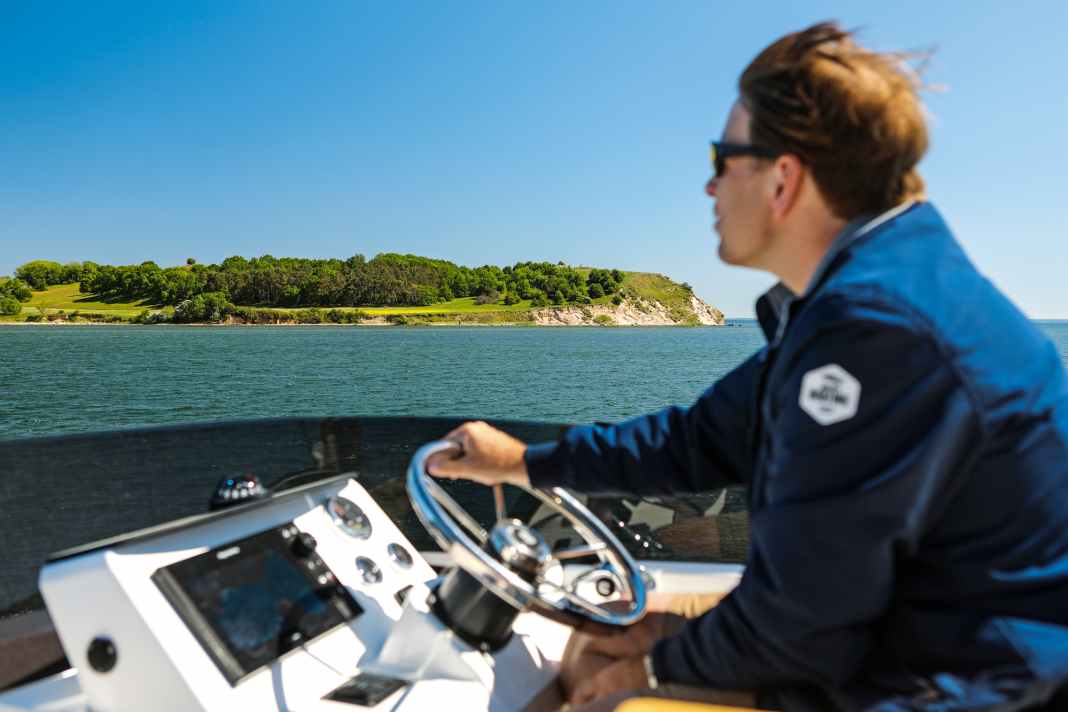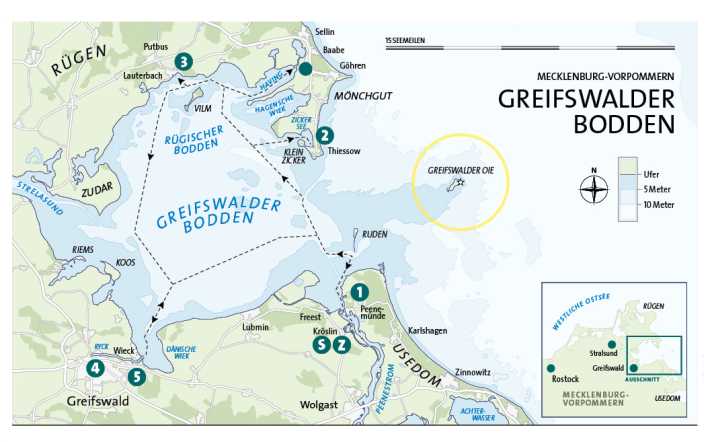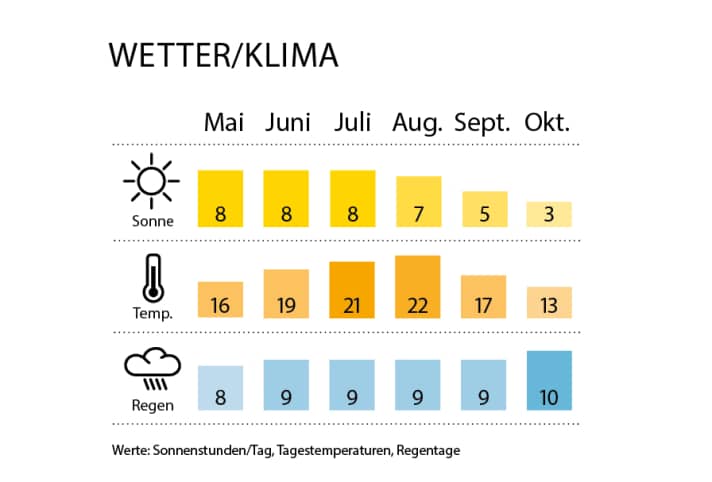





The season is finally starting! The raging virus has caused a delay of many weeks, and with every additional day spent at home, the desire to get back on the water has grown. May is almost over too, but now the wait is over. At least you can travel within Germany again. Our new start is in the north-east, on the east coast of Mecklenburg-Vorpommern. We take over a Beneteau Swift Trawler 35 from Yachtcharter Schulz in the Kröslin marina on the south bank of the Peenestrom. In the coming week, we want to sail around the Greifswalder Bodden, via Usedom to Rügen and return via Greifswald. It will be the first real nautical miles ever for the brand new boat.
Wind from the north-east with force five, gusting to six
The area is not without its challenges: if the wind comes from the north-east, the open flank of the Bodden, an unpleasant, short sea can quickly build up due to the shallow water. Our weather today: wind from the north-east, force five, gusting to six. But we haven't been sitting at home all this time to have our plans thwarted again - even before the start of this trip. We don't have to go straight to Mönchgut, our first destination on Rügen. We decide in favour of Peenemünde on Usedom. It's not much more than a ferry trip, as the harbour is within easy reach just opposite on the north side of the Peenestrom, but we don't mind the wind on the short passage.
We head for the northern harbour, a large basin with a brand new formation of white holiday homes on one side and rustic boat trailers on the other. The permanent berths make for a colourful mix. Some of the floating jetties and the service building are just a week old when we visit, says the harbour master. The area is surrounded by a deep birch forest. The Volksmarine operated a shipyard here until reunification, but hardly any traces of its former use remain - a real idyll!
In the north-west of Usedom, pine forest grows over the island's history
Peenemünde itself is two kilometres away; the town is dominated by the former power station. The block houses the fascinating exhibition of the Historical-Technical Museum. As well as documenting Peenemünde's general military past, which stretched back to 1996, the exhibition focuses on its darkest chapter during the Third Reich: it was here, so close to the Baltic Sea beach, that Wernher von Braun, one of the most controversial personalities of his time, developed and perfected Hitler's wonder weapons, including the Aggregat 4, with an army of engineers until shortly before the end of the war. Better known as V2, the world's first ballistic missile not only claimed the lives of thousands of civilians, but also tens of thousands of forced and slave labourers.
Von Braun himself survived the war and was even able to realise his dream of conquering space. Under his leadership, the Saturn V launch vehicle was later created in the USA, which took the first humans to the moon. The overgrown remains of the test stands from which V2s were fired for testing purposes can still be found today near the coast, in the middle of the peaceful pine forests in the north-west of Usedom.
Although the wind is still in the north-east the next morning, it turns back to the north over the next few hours and decreases slightly. We leave the Peenestrom, which soon flows into the Bodden. The fairway remains narrow, first heading towards the small island of Ruden and then turning back towards Rügen. A whole procession of sailors comes towards us, probably already on their way home at the end of the Whitsun weekend. Further out, more sails can be seen. Nobody has reefed, a good sign. But the sun is blazing. We keep a NNW course until the main channel of the land depression enters from the sea at the "Böttchergrund Ost" and "Landtief West" buoys and we drop off a little. The cape effect is now clearly noticeable and continues to increase until we reach the Mönchgut land shield and the approach to Thiessow.
Blue expanse, warm wind: Mönchgut feels Mediterranean
Between the Groß and Klein Zicker peninsulas lies a shallow bay - the Zicker See - similar to a lagoon. The light-coloured edge of the safe channel can be seen with the naked eye as we carefully head towards the harbour. Its basin is small and used to be reserved for fishermen. Today, the dozen or so guest berths are almost completely full despite the early hour. It's obvious why the harbour is so popular: the surroundings are spectacular, with rolling hills, the Bodden on one side and the open sea on the other. We register with the friendly harbour master and then mingle with the day trippers and holidaymakers. After endless weeks in lockdown, the mood feels liberated. We walk along the dyke over the narrow headland to Klein Zicker, through the pretty village and up to the banks of the Saals. The blue expanse spreads out, a warm wind blows over the dry grass. Mönchgut feels incredibly Mediterranean right now! The advertising slogan "Rügen's most beautiful corner" hardly seems an exaggeration. A plaque tells us that two hundred years ago, the Swedes even wanted to turn this place into a fortified harbour town. What that would have looked like: a little Karlskrona in Western Pomerania.
On the way back, we stop off at the Mönchguter Fischerklause for fresh cod and then secure a box seat for the sunset: the Thiessow beach begins right behind the restaurant, from where a path leads through flowering bushes close to the cliff edge up to the Lotsenberg. But it goes even higher, above the treetops: From the viewing platform of the Lotsenturm tower, the view extends in all four directions. The beacon on Greifswalder Oie in the east is already flashing.
A prince incidentally gave Rügen its first seaside resort
The next morning is market day. Corona makes the rules: Admission is by ticket only. The area is full of stalls and stands. There is Baltic Sea coffee with sea buckthorn, pirogues from Poland and grandma's quark balls. A one-man band in striped shirts provides the musical background with strong vocals. We cast off and leave the Zicker See, the next waypoint is the "Reddevitz" buoy. Once again, the rough waves make for a bumpy ride. The Bodden seems empty, Whitsun is over and the skippers from the capital are back in their offices behind their desks - or in their home offices.
For a stopover on the way to Lauterbach, we head for Having, another elongated bay. From here, a navigable connection leads to Lake Sellin, the Baaber Bek. The harbour in Baabe had been recommended to us in Peenemünde, the location in the middle of green meadows is really wonderful and the guest jetty with boxes is still quite new. If you stay here: The beach promenade on the lake side is two and a half kilometres away. There is also a restaurant, Solthus, right on the harbour.
Vilm was already a restricted area in GDR times: A holiday settlement was built for the comrades of the Council of Ministers
From Having, our course now leads across Stresow Bay towards the south coast of Rügen. To port lies the elongated island of Vilm, whose beech forests are among the oldest in Germany. This is one of the reasons why it is designated as a core zone of the South-East Rügen Biosphere Reserve and access is severely restricted. The passenger ship "Julchen" takes a maximum of 60 visitors a day from Lauterbach on guided tours. Vilm was already a restricted area in GDR times, but for a different reason: back then, it was the visitors themselves who were to be protected from prying eyes by dense woodland. A holiday settlement was built for the comrades of the Council of Ministers. The thatched houses still stand today. The Honeckers also came here to recuperate from their tireless efforts on behalf of the working class.
After we have passed Vilm, the approach to Lauterbach begins. The im-jaich marina not only offers a complete service from the water tap to winter storage, but also a whole "holiday world": Boats share the jetties with pile houses and swimming houses, which can be hired. Incidentally, those seeking harmony with nature do not have to cross over to Vilm: The "Path of Leisure and Knowledge" begins on the northern shore of the small bay opposite the harbour and leads the seeker to the Goor, a wooded area of copper beeches and English oaks, which is also part of the biosphere reserve but can be walked through. Those looking for a more sophisticated experience can take the road to Putbus, around two kilometres away. It is rare to see so much splendour in such a small town: The palace and circus, the theatre in the old stables, the orangery, all in dazzling white, classicism par excellence. Plus the opulent park. The residential town was founded in 1810 by Wilhelm Malte the First, Prince of Putbus, who incidentally also gave Rügen its first seaside resort. Only his castle is missing; it was blown up in 1962. However, there are plans to rebuild it. Berlin sends its regards!
Chains rattle, and the wooden supporting structures creak open for the sailors
It's time to say goodbye to Rügen! The journey now takes us southwards, over to the mainland and the Dänische Wiek. After our morning in Putbus, time flies by this time; the wind has dropped considerably and is now coming almost from astern anyway. After leaving the Zudar peninsula, which still belongs to Rügen, on our starboard side, we cross the eastern exit of the Strelasund and, after two more course changes, find ourselves in front of the mouth of the River Rieck, which leads to Greifswald. We pass the open barrage and the historic bascule bridge, Wieck's landmark, lies ahead. We are a little too early for the opening time on the hour at 5 p.m., and two sailors are already waiting. Then we discover a free, sufficiently wide box at the harbour office. We quickly decide to moor up.
After registering, we stroll to the bridge, where the attendants are working hard on the cranks. Chains rattle and the wooden supporting structures creak open for the sailors. We pick up some fried fish at the Reusenhaus, cross the closed bridge from Wieck to Eldena on the south bank (both are districts of Greifswald) and eat our delicious "catch" on the beach of the Dänische Wiek.
Faith, hope and love - not the worst motto
At 10 a.m. the next day, we start cranking. The following stretch on the Ryck is short but beautiful, a real river trip. Waving reeds on both sides, the dyke on the port side with a cycle and footpath and tall trees behind it, flood meadows on the starboard side. In between a jetty, then after two nautical miles more and more moorings on the shore, a new development area, the marina yacht centre and finally the museum harbour, where two moorings have just become available at the guest pier near the fishing tower (with the harbour master's office). In front of us is a Dutch tjalk with a Bible verse on the bow: "Cor. 13:13". Google tells us what it means: "Faith, hope, love". Speaking of names: Greifswald calls itself a Hanseatic and university town - and quite rightly so. There are 10,000 students for every 60,000 inhabitants, many of whom are sitting in the sun on the riverbank today, two beach bars are serving drinks, and Lou Reed's voice hovers over the water: "Oh, such a perfect day".
We are drawn towards the city centre, flanked by gabled facades from the late Renaissance, concrete slabs from the GDR era and university buildings of all ages and everywhere. But even here, all roads lead to the centre, where the power of the Hanseatic League was immortalised in brick. The town hall and the towering Nikolaidom cathedral epitomise this era. A wonderful end to our cruise around the Greifswald Bodden - and the perfect time for a break. The Störtebeker brewery pub on the east side of the market square is just right! We take a table outside on the pavement and let all our new impressions pass us by once again. A place in the fresh air is always the better choice - and not just in times of pandemic.
Area information Greifswalder Bodden
Cruising stages

S Kröslin-Peenemünde (Usedom): 2 nm
- Peenemünde-Thiessow (Rügen): 13 nm
- Thiessow-Baabe (Rügen)-Lauterbach (Rügen): 18 nm
- Lauterbach-Wieck: 17 nm
- Wieck-Greifswald: 3 nm
Z Greifswald-Kröslin: 21 nm
Total: 74 nm
Literature
"Flensburg-Gdansk Harbour Guide". 300 pp., 278 aerial photographs and harbour plans, spiral-bound, format: 25.3 x 33.3 cm; 69.90 euros. ISBN 978-3-89225-720-2. www.delius-klasing.de
DK-Sportbootkarten Set 2: "Mecklenburg-Vorpommern bis Bornholm" (including digital nautical chart for PC, tablet and smartphone); 69.90 euros. ISBN 978-3-667-11917-9. www.delius-klasing.de

The TOP 3 in the district
- Nature Walks ashore and other hikes become a special experience thanks to the unusual hilly landscape and many viewpoints on Mönchgut. The highest point of the cliffs near Thiessow is also known as the Kleiner Königsstuhl.
- Architecture From Putbus or Baabe, you can take a trip to the Granitz hunting lodge (completed in 1844), the most visited castle in Mecklenburg-Vorpommern.
- TechnologyIn addition to the Historical-Technical Museum, the harbour of Peenemünde also has two extraordinary museum ships: a Volksmarine missile corvette and a Soviet missile submarine.
OUR BOATBeneteau Swift Trawler 35 - Semi-planing - Length: 11.29 m - Width: 3.96 m - Draft: 1.17 m - Motorisation: 1 x 425 hp, bow and stern thruster - Fuel tank: 800 l - Water tank: 300 l - Equipment: Plotter, electric anchor winch, electric WC - Cabins: 2 (1 double, 1 single berth) - 1 wet room (WC, shower) - Weekly rates: 1415 to 2840 euros.
CHARTER: Yachtcharter Schulz is one of the largest providers in the north-east and currently has a network of six bases in the inland area and on the Bodden coast, between which one-way trips are also possible. There is also one base each in the Netherlands (Friesland) and Poland (Masuria). The fleet comprises boats for up to 12 people. In our case, the starting point and destination was Marina Kröslin in Mecklenburg-Vorpommern. Contact: Yachtcharter Schulz. An der Reeck 17, 17192 Waren/Müritz, Tel. 03991-12 14 15. www.charter-schulz.de
Nautical information
The precinct
With an area of around 500 km2, the Greifswald Bodden is by far the largest body of water of its kind along the Baltic coast of Mecklenburg-Vorpommern. Like all lagoons, it is quite shallow; the average depth is 5.6 metres, although there are many much shallower areas, especially near the coast. This is another reason why it is important for those unfamiliar with the area to keep to the buoyed fairways. Additional restrictions and rules also apply to areas designated as protection zones I and II of the South-East Rügen Biosphere Reserve.
Further information can be found on the nautical chart, in the nautical literature and on the Internet at www.elwis.de (Search term: Rügen navigation regulations)
Driving licence
The official "Sport boat licence, area of validity sea" is required for the boat in the area.
Harbours
The nautical infrastructure is good in all parts of the area, most of the moorings are pile boxes, larger marinas also have floating docks. The harbours we visited were: Marina Kröslin , Peenemünde North Harbour Thiessow harbour, Marina Lauterbach Wieck harbour, Museum harbour Greifswald.

